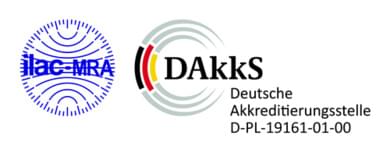Asbestos in baby powder: Johnson & Johnson wants to end legal dispute with 8 billion euros
For years, baby powders made by Johnson & Johnson have been suspected of being contaminated with asbestos and causing cancer. In 2018, investigative journalists from Reuters accused the pharmaceutical company of having known about partially asbestos-contaminated talcum powder products as early as the 1970s, while publicly continuing to assert that they were asbestos-free. As evidence, Reuters cited internal documents such as test reports in which various laboratories sometimes detected "quite high" levels of asbestos in J&J cosmetics.
Meanwhile, Johnson & Johnson faces about 40,000 lawsuits (some sources say more than 60,000 lawsuits). Many plaintiffs blame the "Baby Powder" product for causing them to develop ovarian cancer. To settle the lawsuit, J&J recently offered a settlement payment of 8.1 billion euros ($8.9 billion). Whether the plaintiffs and the court will accept it is still unclear.
How does asbestos get into baby powder?
The mineral ingredient talc absorbs moisture and improves the texture of products. As a result, talc has been used for decades in personal care products such as baby powder, body and face powders, deodorant powders, eyeliner pencils, and lipliners.
U.S. scientists attribute the fact that asbestos regularly finds its way into talcum powder to the nature and locations of talc mining. For example, they say, the mineral deposits used to manufacture U.S. products are consistently contaminated with amphibole asbestos such as tremolite and anthophyllite.
Is asbestos only found in U.S. cosmetic products?
No, asbestos in talc is not a purely U.S. problem. For example, a 2019 study showed that asbestos is also common in Indian talc products [Fitzgerald et al. 2019].
In our laboratory, we have investigated numerous talc raw materials, soapstones, and talc-containing products in the past, including cosmetics. We have regularly detected asbestos fibers - particularly the amphiboles tremolite and anthophyllite, and rarely actinolite and chrysotile. The problem is therefore also likely to exist here in Europe.
In which areas is talc used?
Cosmetics is only a small area of use for talc. It is also used as a filler in the industrial production of paper and pulp, paints and coatings, and rubber, plastic, and ceramic goods. Other applications include medicine (powder base, lubricants) and the food industry. Less well-known is that talc is also used as an extender for marijuana.
Can asbestos cause ovarian cancer?
Several studies have found a striking clustering of ovarian cancer cases in women who had been exposed to asbestos-contaminated baby powder [Berge et al. 2018][Steffen et al. 2020][Slomovitz et al. 2021]. Thus, there is at least the possibility that asbestos can cause serious diseases – even beyond the known lung diseases caused by inhalation of fibers.
60% of all mesotheliomas in women are not work-related
Mesothelioma (pleural cancer) is known to be an asbestos-related occupational disease. However, according to research, about 60% of all mesotheliomas in women cannot be attributed to work-related exposures. While mortality from asbestos-related diseases fell for men from 1999 to 2010, it remained stable for women [Baumann & Carbone 2016]. Men still lead in the total number of diseases, but in the under-50 age group, women and men are tied.
These figures suggest that asbestos in everyday products (such as cosmetics) has far-reaching consequences – especially if these products are atomized and applied to the face during their use. There is then a high risk of inhaling asbestos fibers. Because typical asbestos-related diseases have a very long latency period of 20 to 30 years, it is often impossible to attribute cases to definite exposure.
For more info on asbestos in talc - including exciting details on measurement methods and detection limits – read the blog post by our colleague Dr. Gunnar Ries: Asbestos in talc, more than a cosmetic problem!
Further sources:
- Reuters: Johnson & Johnson knew for decades that asbestos lurked in its Baby Powder
- Spiegel: Krebsverdacht bei Babypuder: Johnson & Johnson bietet acht Milliarden Euro für Vergleich
- NBC News: J&J prepares to pay out $8.9 billion to settle talcum powder lawsuits
- Sage Journals: Asbestos Contamination in Talc-Based Cosmetics: An Invisible Cancer Risk
- Berge, W., Mundt, K., Luu, H. & Boffetta, P., 2018, Genital use of talc and risk of ovarian cancer: a meta-analysis, European Journal of Cancer Prevention, 27, 248 – 257.
- Steffen, J.E., Tran, T., Muna, Y., Clancy, K., Bird, T.B., Rigler, M., Longo, W. & Egilman, D.S., 2020, Serous Ovarian Cancer Caused by Exposure to Asbestos and Fibrous Talc in Cosmetic Talc Powders—A Case Series, Journal of Occupational and Environmental Medicine, 2, 65 – 77.
- Slomovitz, B., de Haydu, C., Taub, M., Coleman, R. & Monk, B.J., 2021, Asbestos and ovarian cancer: examining the historical evidence, Int J Gynecol Cancer, 31, 122-128
- Fitzgerald, S., Harty, E., Joshi, T.K. & Frank, A.L., 2019, Asbestos in commercial Indian talc, American Journal of Industrial Medicine, 62, 385 – 392.
- Baumann, F. & Carbone, M., 2016, Environmental risk of mesothelioma in the United States: an emerging concern—epidemiological issues, Journal of Toxicology and Environmental Health, Part B, 19, 231 – 249.


